The Food & Wine Guide to Culinary Cannabis
On a recent Friday night, I got together with 180 strangers to get stoned.
We convened at a swank event space at the invitation of 99th Floor, a cannabis dinner party pop-up company helmed by Jeepney chef Miguel Trinidad.
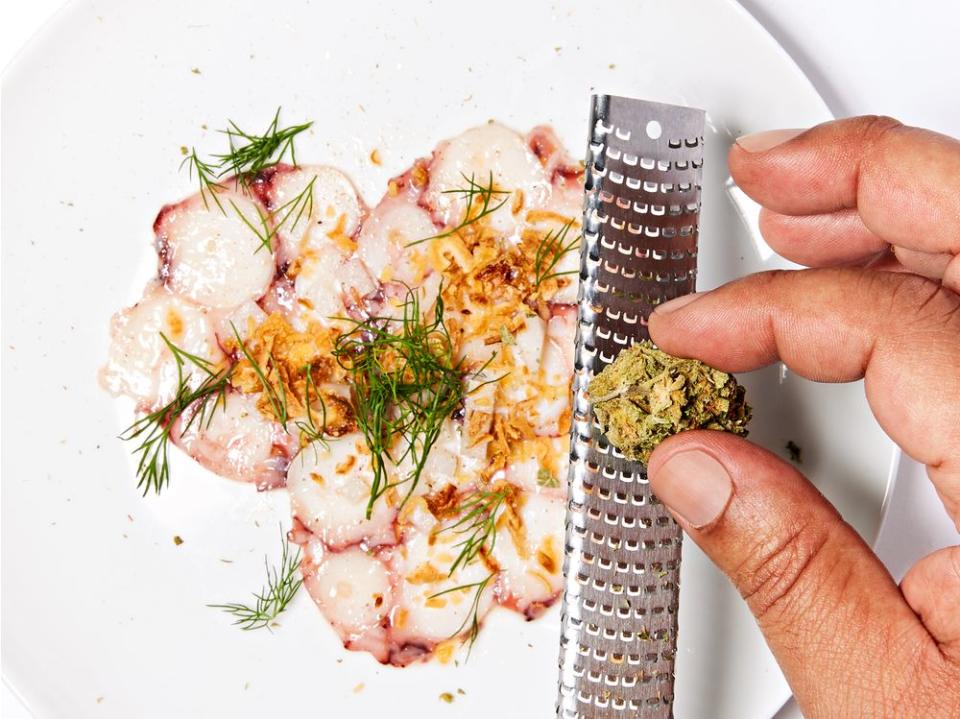
“We want to destigmatize cannabis through the universal language of food,” Trinidad said, before sending out a tour de force of cannabis cooking: Weed permeated the stock for the beef shank served in a gingery broth with spaetzle and fry bread; its flower was shaved over a carpaccio of charred, cannabis-infused octopus; terpenes, nonpsychoactive aromatic chemical compounds from the cannabis plant, provided floral notes to the roasted fennel that accompanied lamb chops that had been cooked, sous vide, in infused fat. (And my fears aside, nothing tasted like bong water. It was all delicious.) As each course was served, Trinidad called attention to where THC (the compound responsible for marijuana’s psychoactive effects) was incorporated—in a smoky eggplant puree with the carpaccio, in a Bordelaise sauce on the lamb—allowing us to moderate our intake somewhat. It was good that I’d talked to Trinidad about all of this ahead of time, because somewhere between the second and third courses, my eyeballs started feeling really weird, and my notes from the rest of the dinner were limited to: “Feeling great. Mirage burps. Womp womp.”
Trinidad and his business partner, Doug Cohen, compare their approach to cannabis as analogous to a fine-dining meal with wine pairings. “The goal is not to have you hammered,” says Cohen. “It’s a journey of the senses, an experience.”
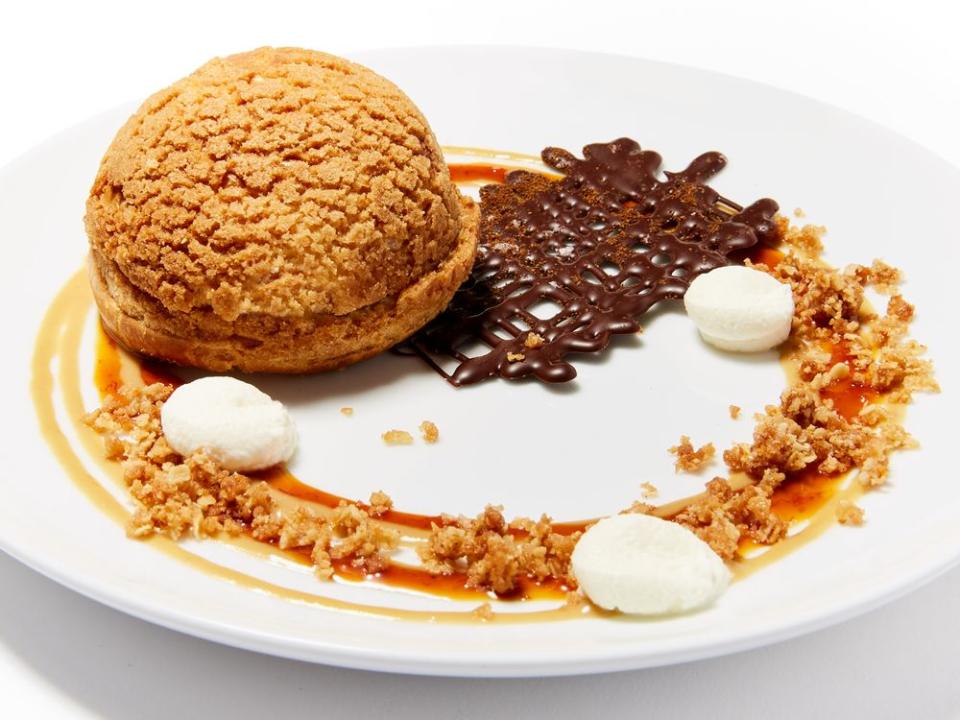
99th Floor is one of many new businesses working to meet the new cannabis consumer: me, and maybe also you. Thanks to the growing social acceptance and legalization of cannabis, the number of adults trying it for the first time is skyrocketing. And an awful lot of us aren’t smoking it—we are eating and drinking it.
According to studies by Arcview Market Research and BDS Analytics, which studies cannabis consumption, the top growth category is consumable cannabis. For the most part, that means edibles, which is a section of the cannabis market that has evolved far past the pot brownie; it also includes THC- and CBD-infused drinks, even ice cream. And across the nation, chefs and diners are exploring the versatility of the cannabis plant at the table in ways Jerry Garcia could never have imagined: infusing foods, pairing inhaled marijuana with food, and mining the spectrum of flavor profiles and distinct psychoactive effects of different cannabis strains.
At 99th Floor, I was lucky to be in the hands of a chef who was conservative with the dosing, so I left the evening pleasantly buzzed and not too high to find my way home. But it’s the wild west when it comes to culinary cannabis, and for every carefully dosed dinner party series, there's somebody eating too many THC-laced gummies and having a terrible night. Wondering how to navigate this new world? Read on. —Executive Editor Karen Shimizu


The Basics
Put simply, marijuana and hemp are cousins in the cannabis family. The primary difference is that marijuana contains more tetra-hydrocannabinol, or THC, which has psychoactive effects on the human brain. Hemp, on the other hand, has extremely low levels of THC (0.3% or less) and is nonintoxicating. Both contain scores of cannabinoids (including cannabidiol, or CBD) and terpenes, which are aromatic chemical compounds that many believe can aid relaxation, cause changes in mood, and decrease inflammation. Most CBD on the market is derived from hemp and has no psychoactive effects.
Without guidelines from the FDA (which is still exploring how to regulate CBD), it’s critical that consumers do their homework before purchasing CBD products. Ashlae Warner of SuperGood, a CBD company based in Denver, recommends going to a company’s website and looking for the Certificate of Analysis (COA), or third-party testing results that show the quantity of cannabinoids in the product. If the company won’t share one, move on. When it comes to THC edibles, states where recreational marijuana is legal, including California, Colorado, Massachusetts, and Nevada, require testing for potency and contaminants by a third-party laboratory—but standards vary. A good sign that the product you’re considering is legit? Prominent dosing information and testing by an accredited lab right where you can see it: on the label or on the website.
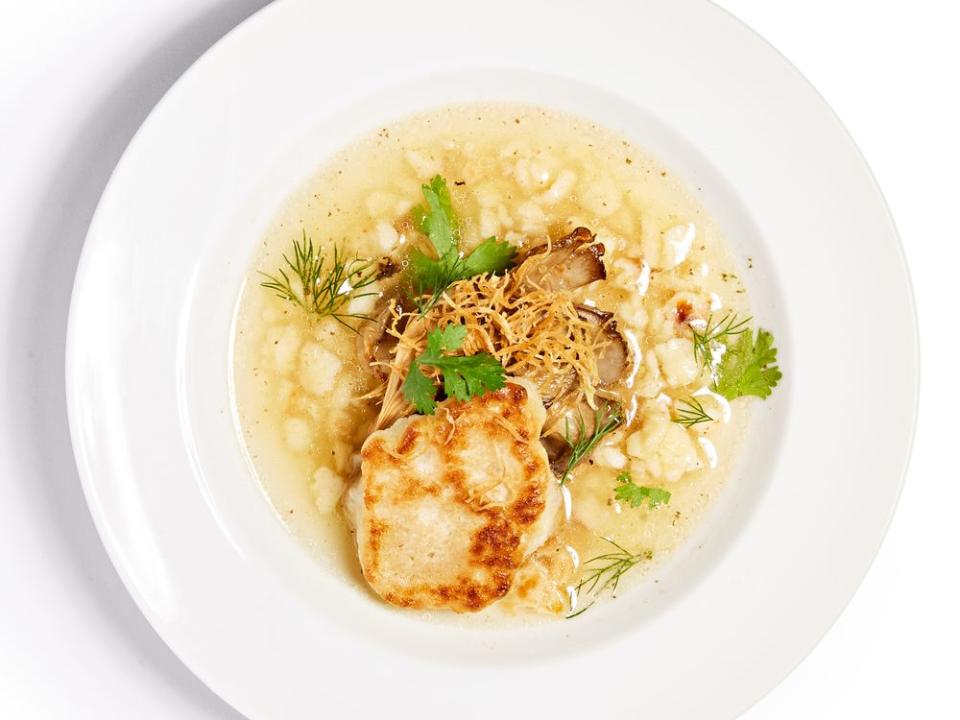
Cooking with Cannabis
Cooking with marijuana demands an understanding of decarboxylation, the process of heating the cannabis flower that breaks the carbon chain, converting tetrahydrocannabinolic acid to THC, to give cannabis its effects. Do it wrong and at best you’ll fail to unlock its psychoactive properties; at worst you’ll ruin the bud altogether (expensive mistake!). Plus, unless you’re testing for THC, you won’t know how much you’re consuming. An alternative option is purchasing packaged products that do the work for you.
How to Make Cannabutter, Step by Step
Premium Cannabutter Recipe
Recipes to Make Using Cannabutter
Cannabis-Infused Brioche French Toast
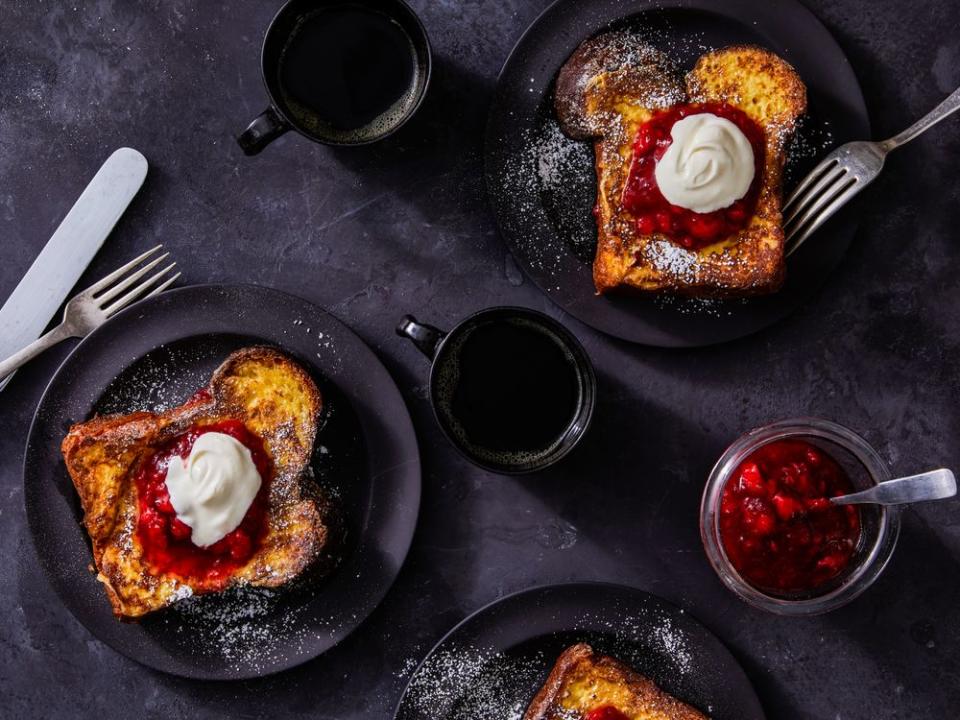
Cannabis-Infused Pasta with Clams and Green Chiles
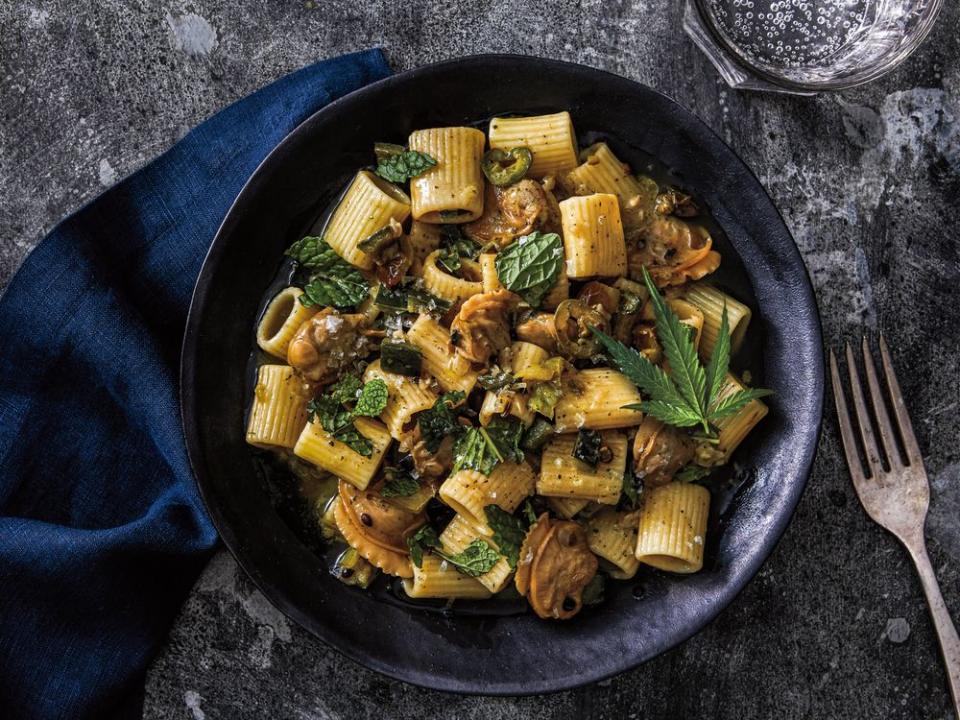
Cannabis-Infused Citrus-Caramel Blondies

CBD Ingredients for At-Home Cannabis Cooking
House of Spain Olive Oil
Amanda and Peter Gillies infuse their premium and highly sought-after olive oils with CBD from Oregon’s East Fork Cultivars ($34–$49, houseofspainevoo.com/).
Canna Bees Honey
This Texas wildflower honey delivers CBD couched in raw honey, and each jar sold also helps raise money to keep bee colonies safe ($39, beedelightful.com) .
THC Ingredients for At-Home Cannabis Cooking
Sweet Grass Cannabutter
These THC-infused sticks of butter are scored in tablespoon (10 milligram) doses and come in attractive packaging ($20, sweetgrasskitchen.com.
Ruby Sugar
You can use this THC-infused sweetener as you would any other—in baked goods, sprinkled on fruit, or stirred into iced tea ($10 for a 10-serving box, rubyedibles.com).
If you’re intent on making cannabutter at home, these two nifty infusers make life easier—just be mindful of temperature and time.
Magical Butter
This all-in-one infuser looks like a coffeepot. Add your plant material, some butter, close the lid, push a button, and presto: infused butter in two hours ($175, magicalbutter.com).
Levo
Although not specifically made for cannabis use, this gizmo is designed for infusing botanicals into oil and butter and comes in multiple happy colors ($150-$350, levooil.com).
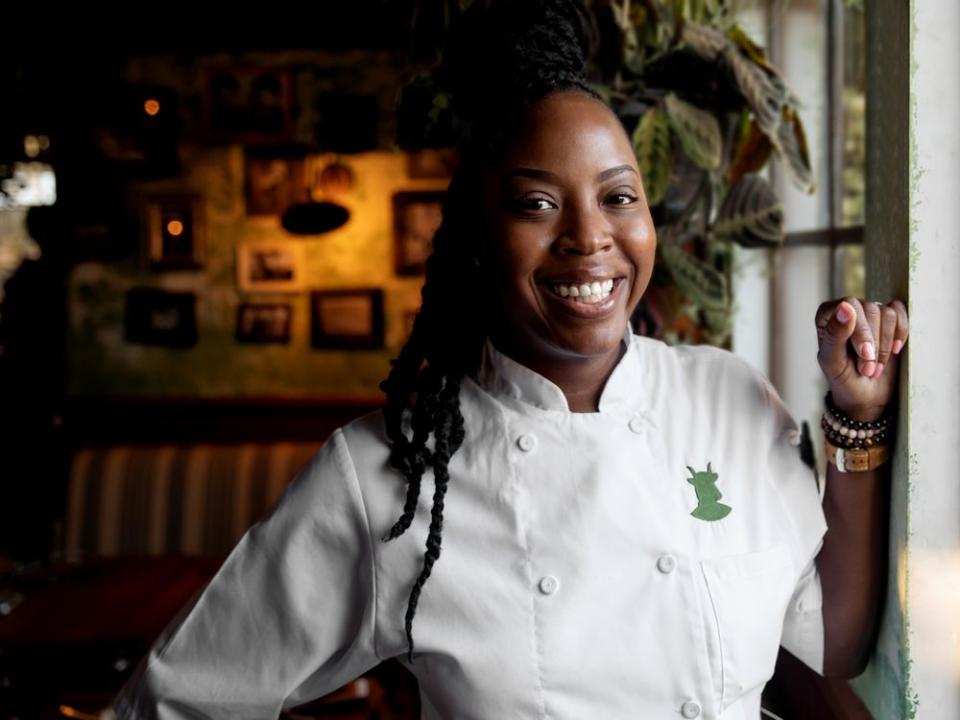
The First-Ever Legal Cannabis Restaurant
At the Original Cannabis Cafe in Los Angeles, guests can openly smoke pot and eat infused edibles while snacking on vegan nachos and sticky tamarind wings. Its opening represents the culmination of three-and-a-half years of legal hoop-jumping and bureaucratic negotiating. Guests order food and drinks from one menu, and pre-rolled joints, loose marijuana flower, edibles, and cannabis concentrates from another. Bongs and glass pipes are available for rent. Due to California law, cannabis and alcohol are prohibited from being sold at the same venue, so all drinks are nonalcoholic, though some of them contain cannabis. Nothing on the food menu is infused, and guests can’t take home any leftover cannabis. The idea is to enjoy imbibing before and during your meal, as you would with a glass of wine.
That last point is particularly important to chef Andrea Drummer. The soft-spoken 47-year-old wants to destigmatize cannabis consumption in the U.S. “There’s no better way to normalize [cannabis] than by combining it with something we do every day: eat,” Drummer says. “It’s two communal experiences at once.”
She hopes that the restuarant and other operations like it will help change both the cultural perception of cannabis and the legal status quo. Despite more states legalizing, cannabis arrests are rising, and according to the ACLU, black users are nearly four times more likely to be arrested than white, despite roughly equal usage.
The cafe is attempting to counter some of that disparity by offering a Social Equity and Reparative Justice Program, which gives employment priority to recently pardoned nonviolent cannabis offenders reentering society. Drummer is outspoken on this point. “Why is it that I get to earn a living by doing something that’s normal, while other people are doing life in prison?” she asks. —Jamie Feldmar
Read more about the Original Cannabis Cafe
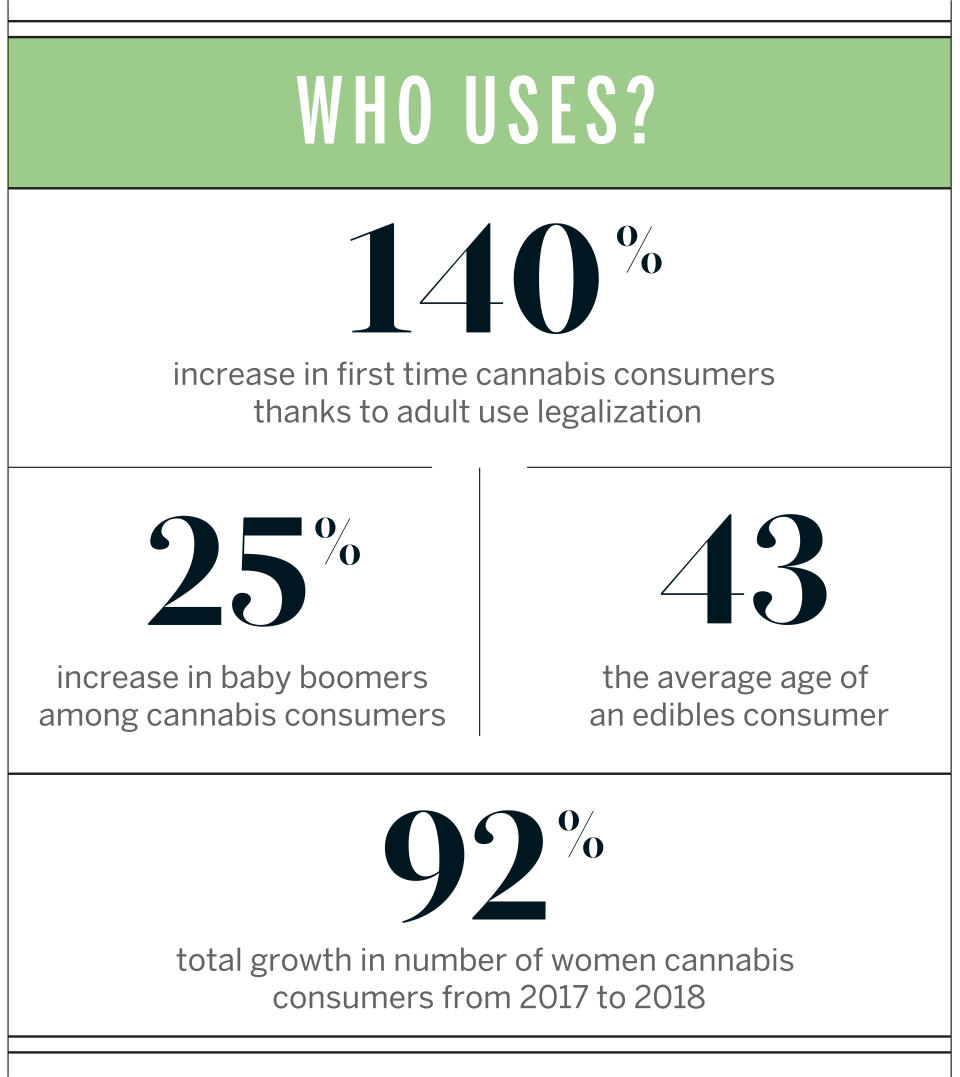
Edibles Grow Up
The most common edible purchased and consumed today is the gummy. “Far and away,” says Greg Shoenfeld, vice president of operations at BDS Analytics, a cannabis analytics company based in Boulder, Colorado. “And these are sophisticated confectioneries.” That, in a microcosm, is the forward motion of the ingestible market, the cannabis industry’s fastest-growing sector, which pulled in $712 million from January 2019 to June 2019, an increase of 27.5% from the previous year.
The new face of edibles is beautiful packaging, refined flavors, and quality ingredients. The sugared gummy pearls of Portland, Oregon–based Grön are a shining example, as is Denver-based Coda Signature’s coffee and doughnuts chocolate bar, dusted just so with cinnamon sugar. “There was an opening for wonderful flavors, quality ingredients, and bringing about nostalgia,” says Lauren Gockley, director of edibles for Coda Signature, who spent two years working with chocolate and pastry under Thomas Keller at Per Se in New York City. In August 2019, Coda also launched a line of high-end fruit chews à la pâte de fruits in flavors such as strawberry rhubarb and, Gockley’s favorite, coconut lime with makrut lime–infused sugar.
The high from an edible is very different (and has a delayed onset) than the one from inhaling marijuana. “Don’t fear the edible; just start slow,” says Laurie Wolf, founder of Laurie + MaryJane, an influential cannabis edibles company in Portland, Oregon.
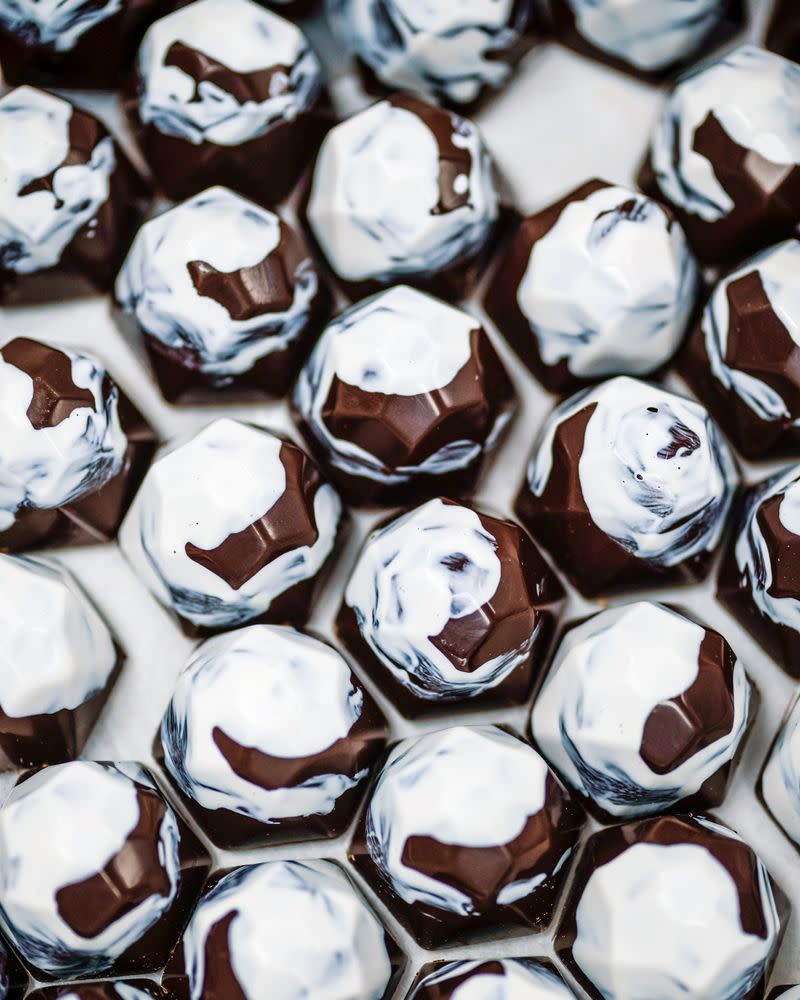
Start Low, Go Slow
Edibles often contain 5 to 10 milligrams of THC, but if you’re new to cannabis, start by microdosing with 1 or 2 milligrams and work up from there. Unlike inhaled marijuana, it can take over an hour to feel an edible’s effects—and the high lasts much longer. So divide a 5-milligram gummy into quarters and eat one piece, or look for smaller doses.
Store Them Safely
Edibles look just like regular treats. To avoid accidental intoxication (especially by children), store edibles in clearly marked bags (such as those from kushsupplyco .com) and way out of kids’ reach.
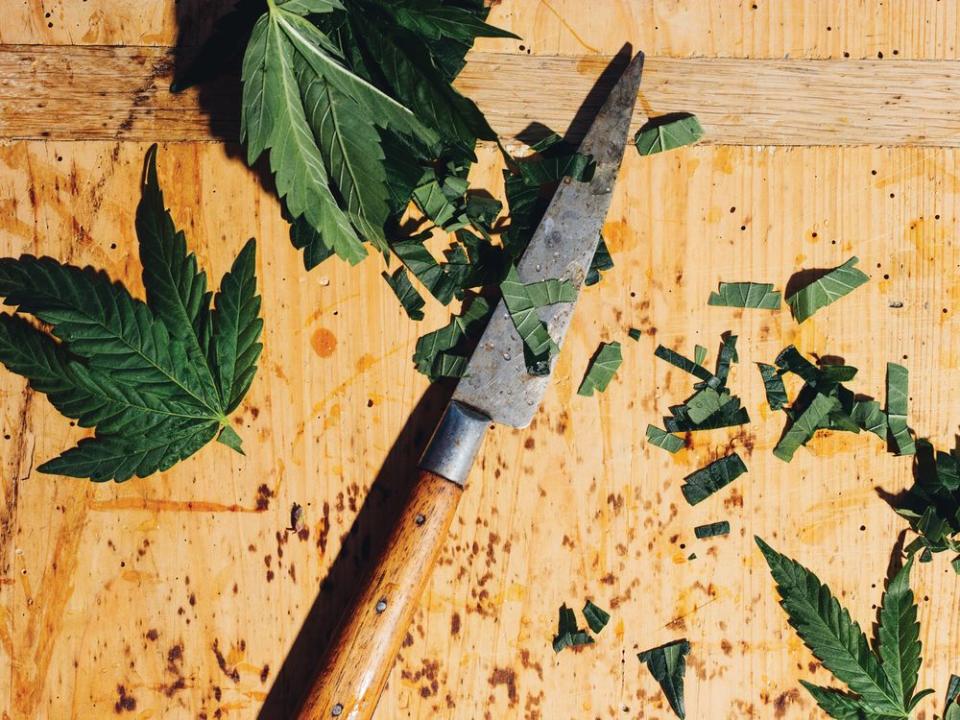
8 Edibles to Look For
99th Floor
Chef Miguel Trinidad will soon launch a line of edibles in California and, once legalization takes hold, New York. Until then, dinner guests can take home a goody bag of THC-infused hard candies. facebook .com/99thfl
Coda Signature
These truffles and chocolate bars are some of the most popular in the Colorado market. “Some people only get half a square, so it better taste amazing,” says Lauren Gockley, director of edibles. coda signature.com
Grön
Premium THC- and CBD-infused chocolate bars, sugar-coated pearls, and chocolate-covered coffee beans in gorgeous, modern packaging from Christine Smith, a Portland, Oregon–based former architect. gron chocolate.com
Laurie + Mary Jane
Cake bites, truffles, cheese crackers, and a potent fudge (called Fudge Yourself and dosed at 50 milligrams of THC apiece) show the range of this Portland, Oregon, company from cannabis advocate Laurie Wolf. laurieandmaryjane.com
Lord Jones
Made in Los Angeles, these dazzling gumdrops (in flavors like green apple) and chocolate confections (like the dark chocolate espresso chews) are infused with CBD and come in boxes suited for fine jewelry. lordjones.com
Mindy's Edibles
Chicago chef Mindy Segal, who won the James Beard Award for Outstanding Pastry Chef in 2012, has turned to creating cannabis-infused cookies, brittles, and more. And yes, there is a pot-infused brownie. mindysedibles.com
Numb Nuts
Adam Weiss, owner of Breckenridge Organic Therapy (a dispensary), and his wife, Carlin Karr, wine director at Frasca Food and Wine, roast nuts and pepitas with maple syrup, rosemary, red pepper flakes, and CBD. numbnutsco.com
Willie's Reserve
Musician Willie Nelson’s edibles company was born out of the dedication his wife, Annie, had to creating high-end marijuana-infused chocolate. Today, the line includes fruity chews and hard candies. williesreserve.com
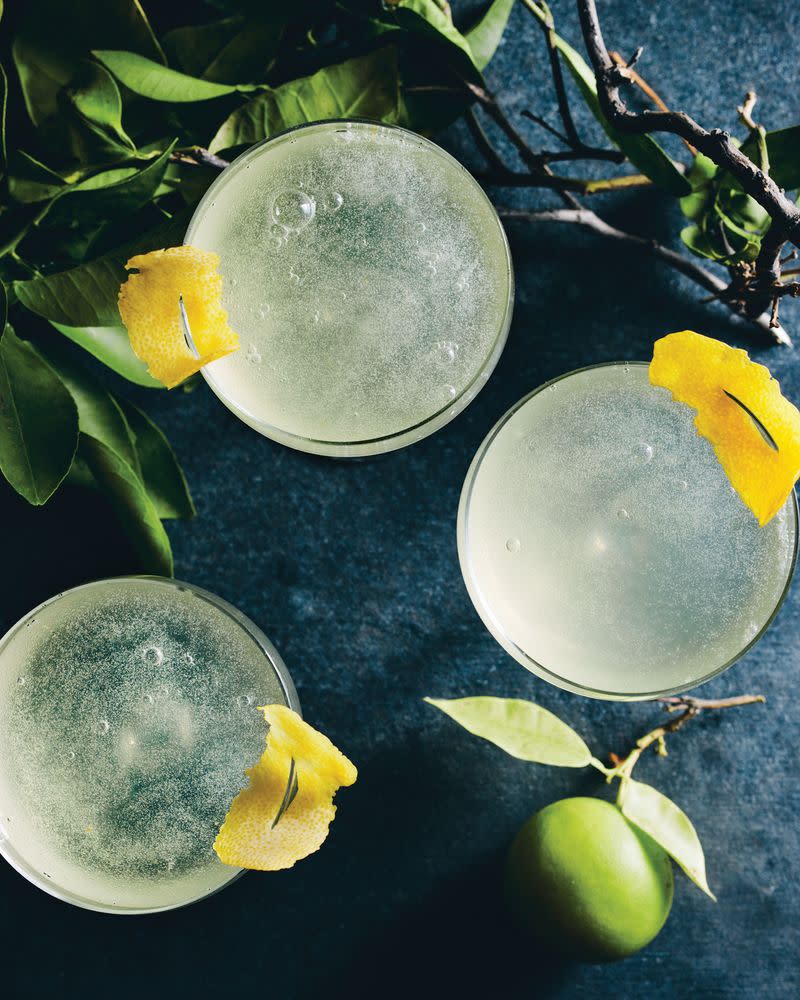
Cannabis at the Table
Pairings vs. Infusions
If an event mentions “pairings,” that means inhaled marijuana will be matched up with courses throughout the meal. There may be a “budtender.” At an infused dinner, THC is in the food.
How to "Taste" a Joint
There’s a three-step tasting method for inhaled cannabis, says Rachel Burkons of Altered Plates. First, nose the unlit marijuana to take in the aroma of the terpenes. Then, do a “dry pull,” or inhale without lighting, to get the flavor on your palate. Finally, once it’s lit, notice the mouthfeel of the smoke. “It’s like a wine tasting—nose, aroma, palate, and finish,” Burkons says.
If You Overdo It
Drink water and take a walk outside. Some chefs recommend taking some CBD. “When people get too high, they get stressed, and CBD helps them relax and gain focus,” says David Yusefzadeh.
Where the Weed Dinners Are
99th Floor (National)
Jeepney chef Miguel Trinidad and his business partner, Doug Cohen, host infused dinners around the U.S.: Think Szechuan noodles with rib eye and infused chile oil (facebook.com/99thfl).
Altered Plates (California)
The brother-sister team of chef Holden Jagger and Rachel Burkons specializes in curated cannabis pairings in and around Los Angeles (alteredplates events.com).
Eat Sacrilicious (Massachusetts)
Boston chef David Yusefzadeh offers a terpene cocktail with his CBD- and THC-infused dishes. Save room for the infused ice cream (eatsacrilicious.com) .
Herbal Notes (Illinois)
At these fine-dining events in Chicago, chef Manuel Mendoza prepares infused fare like THC-cured salmon in a CBD-infused brown butter with a blood orange–koji glaze (herbalnotes.co).
Mason Jar Event Group (Colorado)
Pairings like a joint or a shaving of THC chocolate over dessert allow guests at Kendal Norris’ Denver dinners to set their pace (masonjareventgroup.com).
Michigan Cannabis Chefs (Michigan)
Lynette Marie and Nigel Douglas call their Grand Rapids, Michigan, dinners “field to fork first, cannabis-infused second” (micannabischefs.com).
Sinsemil.La (New York)
This underground New York City supper club focuses its attention on cannabis as part of haute cuisine (sinsemil.la) .
Enhanced ice cream is one of the coolest trends in cannabis cuisine. Here are three to scoop now:
3JS Hice Cream
Launched in Denver on April 1, 2019 (“People thought we were joking,” says cofounder Jonathan Schillace), this THC-infused “hice” cream can be found in flavors like caramel apple pie at dispensaries across Colorado (3jshicecream.com).
Cloud Creamery
In Boston, chef David Yusefzadeh builds his CBD- and THC-infused flavors around ingredients like fresh mint and vanilla beans. Look for them at dispensaries in Massachusetts; one day, he plans to open a scoop shop (cloud creamery.co).
Prohibition Creamery
This Austin parlor’s lineup includes Afternoon Delight, for which owner Laura Aidan infuses a red velvet ice cream base with hemp-derived CBD oil and swirls in cream cheese frosting (prohibitioncreamery .com).

Are cannabis-infused drinks the future of the beverage industry?
Drinks offer an easy pathway to cannabis consumption. “The experience is something that’s familiar,” says Niccolo Aieta, founder and chief technology officer of Colorado-based Spherex, which makes Phyx, a THC-infused sparkling water. “I have a drink [because] I want to celebrate or party or relax.” The earliest adopters of cannabis drinks have been small companies, but big beverage isn’t far behind: Last year, Constellation Brands (whose holdings include Modelo Negra and Corona) invested $4 billion in a Canadian marijuana company, and Heavenly Rx, a hemp- and CBD-focused wellness company, announced a substantial investment in Jones Soda in July 2019. Like alcohol, infused drinks are digested and absorbed into the bloodstream relatively quickly. The onset of the high can be faster than with edibles, and imbibers can more easily quantify how much they’re drinking (e.g., a can of sparkling water) and pull back as needed.
Beer Buzz
Cannabis and hops have similar chemical properties, and in Portland, Oregon, Coalition Brewing celebrates their synergy with Two Flowers, a CBD-infused IPA (coalition brewing.com). In partnership with CannaCraft in Santa Rosa, California, Lagunitas Brewing Company makes Hi-Fi Hops, an IPA-inspired sparkling beverage infused with THC. (With 10 milligrams of THC or 5 milligrams each of THC and CBD; sold at dispensaries in California and Colorado.)
If You Like LaCroix
A bottle of Phyx sparkling water contains 2.5 milligrams each of THC and CBD. “You get the feeling of two glasses of wine—calm, relaxed,” says marketing director Kelly Calvillo (wearespherex.com) .
Soda Pot
Seattle-based Olala’s lemon-lime citrus cannabis-infused soda is reminiscent of Squirt. Pick your dose: from 10 milligrams of THC to an obliterative 100 (enjoy olala.com). Sprig’s CBD-infused seltzer line ships nationwide and comes in citrus, tea, and melon flavors (drinksprig.com).
Cannabis Cocktails
Using nanotechnology that renders fat-soluble cannabinoids more water soluble, The Tinley Beverage Company out of Los Angeles created an amaretto-esque almond and apricot THC-infused “liqueur” called Almond Cask. Also look for their bottled takes on classic cocktails: the margarita-ish Stone Daisy and Moscow Mule–riffing High Horse (drinktinley.com) .
Not Your Average Joe
Cascadia Coffee Roasters in Portland, Oregon, launched CBD-infused bottled cold brew in their cafés last August (cascadia roasters.com). And Willie Nelson, the world’s most famous stoner, slings Willie’s Remedy CBD-infused coffee beans, available in medium, dark, and decaf with approximately 1 milligram of CBD per gram of beans (williesremedy.com) .
A Cup of Tea +
Each compostable Keurig pod of Brewbudz Garden of Eden black tea serves up 10 to 50 milligrams of THC (leafly.com). Joy Tea in San Francisco offers bottled iced tea infused with 25 milligrams of CBD (getjoytea.com). In Portland, Oregon, try Camellia Grove Kombucha Co’s CBD-infused kombucha (camelliagrove-kombucha .com) .
THC "Wine"
Napa’s House of Saka takes wine, removes the alcohol, and adds THC and CBD to make Saka White, Saka Red, and the rosé-like Saka Pink (houseofsaka .com). In Sonoma, Rebel Coast’s Sauvignon Blanc serves up 0.5% alcohol and 40 milligrams of THC per bottle (rebelcoast.com).

On the Horizon
The Whole Plant
Lumen makes cold-pressed hemp shots from a minimally processed source. It’s the closest you can get to eating raw hemp leaves (drinklumen.com).
Weed Somms
The Trichome Institute teaches weed somms, or interpeners, to identify terpenes, pinpointing each plant’s psychoactive and medicinal properties (trichome institute.com) .
Better Classification
Marijuana was once categorized two ways: indica, broad leaf, was thought to be sedating; sativa, narrow leaf, stimulating. The industry now sees it on a spectrum, emphasizing a strain’s effects, like “happy” or “calm.” And expect more nuanced labeling: There’s talk of mapping the plant’s taxonomy and its strains to help determine which terpenes and cannabinoids work best for each individual.
Weed Vs. Wine
“Wine country is weed country,” says Jamie Evans, founder of The Herb Somm, a cannabis lifestyle brand in the San Francisco Bay Area and author of the forthcoming book The Ultimate Guide to CBD. With a similar agricultural focus and emphasis on terroir, Evans says, “It makes sense for both industries to come together to collaborate.” There are those who agree, as the rise of canna-tourism and wine-and-weed tours cropping up in destinations like Sonoma County attest. But there are just as many wine growers and vintners who see the cannabis industry as a danger to their livelihood. Because cannabis and wine are farmed in many of the same places, the new crop has been the source of some tension in both industries, which compete for laborers, real estate, and customers.
A Tribute to Terroir
Winemaker Francis Ford Coppola teamed up with sustainable cannabis farmers the Humboldt Brothers for The Grower’s Series, a bottle-shaped tin containing matches, a pipe, rolling papers, three one-gram samples of cannabis flower, and information about each strain’s terroir. Each year the flower will change according to the grower and the harvest, just like wine vintages. Consider it the ultimate stash kit for a wine and cannabis lover (California only, $59, calichill.com) .

